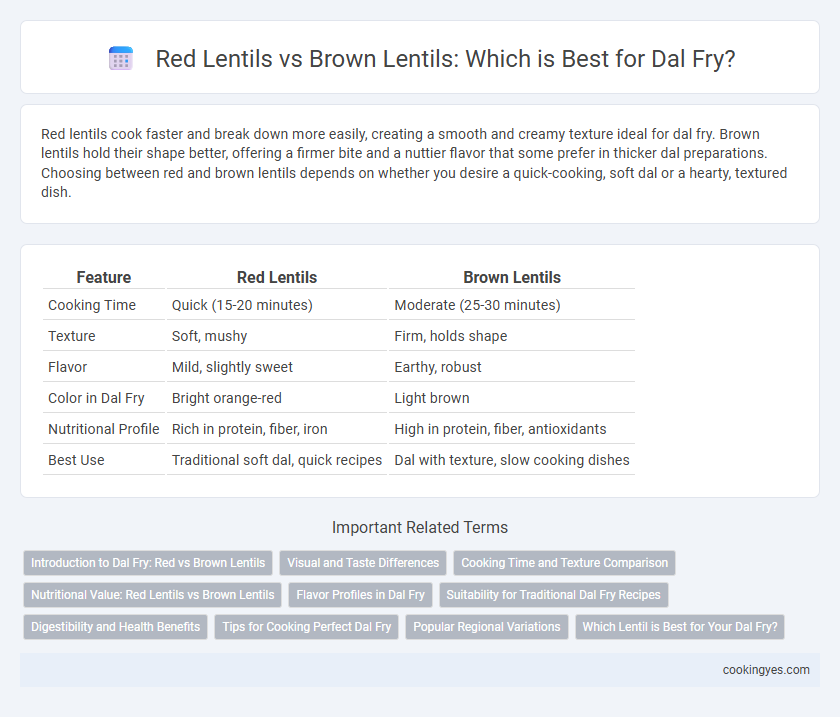Red lentils cook faster and break down more easily, creating a smooth and creamy texture ideal for dal fry. Brown lentils hold their shape better, offering a firmer bite and a nuttier flavor that some prefer in thicker dal preparations. Choosing between red and brown lentils depends on whether you desire a quick-cooking, soft dal or a hearty, textured dish.
Table of Comparison
| Feature | Red Lentils | Brown Lentils |
|---|---|---|
| Cooking Time | Quick (15-20 minutes) | Moderate (25-30 minutes) |
| Texture | Soft, mushy | Firm, holds shape |
| Flavor | Mild, slightly sweet | Earthy, robust |
| Color in Dal Fry | Bright orange-red | Light brown |
| Nutritional Profile | Rich in protein, fiber, iron | High in protein, fiber, antioxidants |
| Best Use | Traditional soft dal, quick recipes | Dal with texture, slow cooking dishes |
Introduction to Dal Fry: Red vs Brown Lentils
Red lentils cook faster and break down easily, making them ideal for a smooth, creamy dal fry with a mild, slightly sweet flavor. Brown lentils hold their shape better, offering a firmer texture and earthier taste that suits dal fry preparations seeking more bite. Choosing between red and brown lentils depends on the desired consistency and depth of flavor in the dish.
Visual and Taste Differences
Red lentils for dal fry offer a bright orange color that creates an appealing, vibrant dish, while brown lentils present a muted, earthy brown hue suitable for rustic presentations. Red lentils cook quickly and break down easily, resulting in a smooth, creamy texture with a slightly sweet, mild flavor; in contrast, brown lentils retain their shape better and deliver a nuttier, earthier taste with a firmer bite. The choice between red and brown lentils influences not only the visual impact but also the sensory experience of dal fry, catering to preferences for texture and flavor intensity.
Cooking Time and Texture Comparison
Red lentils cook faster than brown lentils, typically softening within 15-20 minutes, making them ideal for quick dal fry preparations. Brown lentils require a longer cooking time, around 30-40 minutes, and retain a firmer, more textured bite even after cooking. The softer texture of red lentils creates a creamier dal, while brown lentils yield a chunkier, more robust consistency.
Nutritional Value: Red Lentils vs Brown Lentils
Red lentils contain higher amounts of protein and dietary fiber compared to brown lentils, making them a nutrient-dense choice for dal fry. They are also rich in iron and folate, essential for blood health and cellular function. Brown lentils offer a slightly higher mineral content, including magnesium and potassium, supporting heart and muscle health in dal preparations.
Flavor Profiles in Dal Fry
Red lentils offer a mild, slightly sweet taste that dissolves quickly, creating a smooth and creamy texture ideal for Dal Fry. Brown lentils have a earthier, nuttier flavor with a firmer texture that holds shape during cooking, adding a heartier bite to the dish. Choosing between these lentils influences the overall flavor complexity and mouthfeel of Dal Fry, with red lentils providing a comforting softness and brown lentils delivering robust, textured depth.
Suitability for Traditional Dal Fry Recipes
Red lentils are highly suitable for traditional dal fry recipes due to their quick cooking time and soft, creamy texture that easily absorbs spices, enhancing the dish's flavor profile. Brown lentils require a longer cooking period and retain a firmer texture, making them less ideal for the smooth consistency typically desired in dal fry. Red lentils' vibrant orange hue also contributes to the appealing color of classic dal fry preparations.
Digestibility and Health Benefits
Red lentils are more easily digestible than brown lentils due to their softer texture and quicker cooking time, making them ideal for dal fry dishes that require a smooth consistency. They are rich in protein, B vitamins, and antioxidants, supporting heart health and blood sugar regulation. Brown lentils have a firmer texture, higher fiber content, and provide sustained energy release, which benefits digestion and gut health but may take longer to cook and can be heavier on the stomach.
Tips for Cooking Perfect Dal Fry
Red lentils cook faster and break down more easily, creating a smooth, creamy texture ideal for traditional Dal Fry, while brown lentils hold their shape better, offering a firmer bite and a nuttier flavor. To achieve perfect Dal Fry, soak lentils for at least 30 minutes to reduce cooking time and ensure even softness, and cook on medium heat to prevent splitting or sticking. Season with tempered spices like cumin, mustard seeds, and garlic in hot oil before mixing with cooked lentils for enhanced aroma and rich taste.
Popular Regional Variations
Red lentils, favored in South Indian dal fry recipes, cook quickly and yield a creamy texture that enhances dishes like sambar and rasam. Brown lentils, commonly used in North Indian dal fry, provide a firmer texture and nutty flavor, popular in Punjabi and Gujarati cuisines. Regional variations highlight the preference for red lentils in southern states such as Tamil Nadu and Karnataka, while brown lentils dominate in northern regions like Punjab and Haryana.
Which Lentil is Best for Your Dal Fry?
Red lentils cook faster and break down easily, creating a smooth, creamy texture ideal for dal fry, while brown lentils hold their shape better, offering a firmer bite and a nuttier flavor. For a traditional dal fry with a silky consistency, red lentils are the preferred choice due to their quick cooking time and ability to absorb spices. Brown lentils suit those who prefer a chunkier dal with a more robust texture and earthy taste.
Red Lentils vs Brown Lentils for Dal Fry Infographic

 cookingyes.com
cookingyes.com